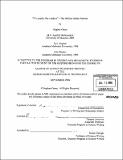"If it quacks like a sphere" : the million dollar problem
Author(s)
Ornes, Stephen
DownloadFull printable version (1.919Mb)
Other Contributors
Massachusetts Institute of Technology. Graduate Program in Science Writing.
Advisor
Thomas Levenson.
Terms of use
Metadata
Show full item recordAbstract
Grigori Perelman, a reclusive Russian mathematician, may have proved the Poincare Conjecture, a statement first poised by Jules Henri Poincare in 1902. The problem is the most eminent challenge in the mathematical field of topology. Perelman posted his proof on the online informal preprint server at arXiv.org. His proof leaves a number of details unexplained. Although he initially participated in the verification of his proof, answering questions to help people understand his work, in the last year Perelman has effectively disappeared from the mathematical community. His absence has caused some controversy in the world of mathematics, where individual mathematicians are usually expected to support their own results. In the wake of his disappearance, other mathematicians are coming together to pore over his work and try to flesh out the details. His apparent desertion raises questions both about the personal risk of mathematicians working at the highest level and the responsibility of the mathematical community in the verification process. (cont.) These questions are further complicated by the fact that the Poincare Conjecture is one of seven problems that was selected by the Clay Mathematics Institute as a Millennium Prize Problem. If a mathematician solves one of the problems, he or she will receive $1 million from the institute. If Perelman's work turns out to point the way to the prize, then the Clay Institute will have to decide how to distribute both credit and the hefty monetary prize.
Description
Thesis (S.M. in Science Writing)--Massachusetts Institute of Technology, Dept. of Humanities, Graduate Program in Science Writing, 2006. "September 2006." Includes bibliographical references (leaves 38-39).
Date issued
2006Department
Massachusetts Institute of Technology. Graduate Program in Science Writing; MIT Program in Writing & Humanistic StudiesPublisher
Massachusetts Institute of Technology
Keywords
Graduate Program in Science Writing.